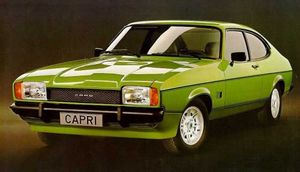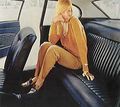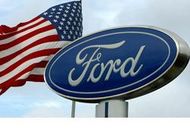.
Ford Capri

| |
| Ford Capri | |
|---|---|
| Ford | |
| aka | The Car You Always Promised Yourself |
| Production | 1969 - 1986 |
| Class | Fixed head coupe |
| Body Style | 2 Door Coupe 3 Door Coupe |
| Length | length - type here |
| Width | Width - type here |
| Height | Height - type here |
| Wheelbase | wheelbase - type here |
| Weight | 1119 kg |
| Transmission | 4-speed Manual, RWD 3-speed Automatic, RWD |
| Engine | 1.3 litre (1298cc) Kent Pushrod I4 1.6 litre (1599 cc) Kent pushrod I4 2.0 litre (1966 cc) Pinto OHC I4 3.0 litre (2994 cc) Essex V6 |
| Power | 52 hp @ N/A rpm N/A lb-ft of torque @ N/A rpm N/A hp @ N/A rpm N/A lb-ft of torque @ N/A rpm N/A hp @ N/A rpm N/A lb-ft of torque @ N/A rpm 205 hp @ N/A rpm N/A lb-ft of torque @ N/A rpm |
| Similar | Toyota Celica (1st gen) |
| Designer | Designer (lead designer if it was a team effort) |
Use the following MODEL TEMPLATE as the foundation for the Wikicars' Model page:
Start off with a brief Introduction to the particular MODEL. Please DO NOT use the same Introduction text from the <MODEL> Review page, but rather paraphrase ideas relevant to grasp an overall scope of the vehicle.
Please include the following line at the bottom of this section. Please replace <MODEL> Review with the proper text:
See Wikicars' comprehensive <MODEL> Review.
Recent Changes
Mention any minor facelifts or major changes made to the vehicle here.
Styles and Major Options
Certain vehicles come in different trim levels or body styles. Features and major options should be mentioned here.
Pricing
Add more fields as necessary.
| MODEL Trims | |||
|---|---|---|---|
| Trim1 | Trim2 | Trim3 | Trim4 |
| MSRP | |||
| $Price1 | $Price2 | $Price3 | $Price4 |
| Invoice | |||
| $Price1 | $Price2 | $Price3 | $Price4 |
Gas Mileage
Add more fields as necessary.
As seen on the FuelEconomy.gov website, the City/Highway MPG averages are as follows:
| Trim | |||
|---|---|---|---|
| Trim1 | Trim2 | Trim3 | Trim4 |
| MPG | |||
| c/h | c/h | c/h | c/h |
Engine and Transmission
Specifications, details, graphs, pictures and other information regarding the powertrain is placed in this section.
Performance
Please make sure to write information of the vehicle's performance in a third-person point of view. This section should include information about the car's acceleration figures, handling, braking, etc.
If using information gathered from Road Test articles from a reputable automotive source, then please make sure to cite the quote.
Reliability
Warranty options and scheduled maintainence information should be mentioned here.
Safety
This section should reference points on safety ratings and features of the vehicle.
Photos
Add Photos of the vehicle here.
Please make sure not to use copyrighted photos.
Colors
List the colors that the particular <MODEL> is offered in.
Main Competitors
Create links to other <MAKE> <MODEL> pages in this section.
Unique Attributes
If there are any features of this vehicle that sets it apart from other vehicles in its class, then mention those unique attributes here.
Interior
This section should include information on the interior's design, build quality, ergonomics, space (head and legroom, front and rear), features, stowage compartments and overall comfort and livability. Add pictures wherever applicable and keep information in a third-person point of view.
Resale Values
Add more fields as necessary.
| <MODEL> Year | |||
|---|---|---|---|
| Year X | Year X-2 | Year X-3 | Year X-4 |
| Resale Value | |||
| $ | $ | $ | $ |
Criticisms
Please make sure to keep critiques in a third-person point of view. If using criticisms from a reputable automotive source, then please make sure to cite the quote.
Generations
First Generation (1969-1974)
Second generation (1974-1978)
Third generation (1978-1986)
The Tickford Capri
The story of the Tickford Capri is a strange and interesting one. Like the earlier German Zakspeed Turbo, the Tickford Capri represented a concerted attempt by Ford to "go beyond" the normal Capri Injection. Also, like the German car, it lost its way when its supporters lost their power inside Ford. Nonetheless, it must surely represent the ultimate evolution of the Capri, the fastest, most luxurious and best handling Capri you could buy from a Ford dealer.
This is where the Tickford differs from all other customised Capris; the Tickford was at the very least a semi-official Ford product. The car had a defined mechanical and trim specification as well as being fully type-approved and available through the UK Ford dealer network. The car was very different from any other Capri, being essentially handbuilt. It could have been a huge sales success in different circumstances, with a lower price and stronger marketing support. Early optimistic projections talked of "around 300" cars being made, in reality only around 100 cars were built. The story of the Tickford is one of "if only".
Tickford began as a small company called Salmon and Son that built up a coachbuilding operation in the 1820s, based in Tickford Street in Newport Pagnell. In the early 1900s the company progressed into developing coachbuilt cars and prospered. "Tickford", as it was now known, was eventually bought by David Brown, Aston Martin's owner. He moved Aston Martin onto the site at Tickford Street where it still remains today and let the Tickford name slide into oblivion.
After several unsuccessful projects, including Lancias and Metros, Tickford realised that the next one would have to be a more expensive vehicle. It would have to be a car that Tickford could re-engineer for more performance and luxury. Such cars that could be modified ideally needed to have an Aston-type flavour that could be built upon. This meant a muscular coupe with rear drive. The Capri Injection was an obvious choice that would potentially generate higher profits from a limited volume than the cheaper MG Metro conversion.
The first car was BHK 573X and appears to have been SVEs development hack, it was probably one of the earliest Capri Injections and may have been the car that was used to test the five speed gearbox. The vehicle log for the black car contained several entries by Rod Mansfield (Head of Ford SVE), unfortunately this car was stolen some years later and was never retrieved. The car had a Tickford turbo engine, the rear spoiler and some minor trim items from the Tickford Capri but was far from being a complete Tickford Capri. The second car handed over by Ford was a white car that was used for trim development and contained all the exterior bodykit and interior trim. This car allegedly ended its days in a crash test needed to gain type-approval. A third car was the first definitive Tickford Capri prototype. This represented the car in near-production form and was the car shown at the 1982 British Motor Show.
The engine was developed by Astons engine development team. They had been tinkering with various turbocharged Aston V8s for some time and thought that they would be able to develop a sophisticated turbo V6 Capri engine. Amazingly, the team initially worked around a turbocharged version of the engine fitted with a carburettor. Whilst a carburettored engine is easier to turbocharge and the Zakspeed Turbo already existed, removing the injection system from the Injection seemed crazy in marketing terms. Thankfully the Zakspeed Turbo engine would not fit right hand drive and the team realised that a carburettored version really was not the answer. They also decided that the engine would have to have an intercooler in the interests of engine longevity and power as well as the Bosch K-Jetronic fuel injection system. The engine was certainly an attractive installation but the Tickfords Achilles Heel was that it was designed by a team who knew only how to design with few constraints on cost. They used equal length manifold pipes, mounting the turbo right at the front of the engine. Here it certainly looked neat and attractive, with the Japanese IHI turbo prominently on view. The team took the view that this installation would reduce lag by keeping the exhaust pulses equal and keeping the turbo cool.
The problem was that it didn't work very well, the car suffered from fairly awful turbo lag. It appears that the Aston theory of keeping the exhaust pulses equal from the engine was fine. However, by mounting the turbo so far away from the engine itself these theoretical advantages were partially eliminated. The Tickford theory was that the equal length manifold pipes would keep the pulses of gas as close together timewise to smooth response. The problem was that these long, equal length, pipes simply served to slow down the gasses by the time that they reached the turbo. These "pulses" are the effects of the engine exhausting the gas at the end of each exhaust stroke of each cylinder. A four cylinder would have fewer pulses (and being more rough in the frequency of gasses reaching the turbo) than an eight cylinder engine. Keeping the exhaust pulses equally timed would be a nice refinement but less necessary on a six cylinder engine where the exhaust pulses are more frequent than a 'four.
Nonetheless, the results of producing the rather expensive Tickford engine were impressive. Bearing in mind that all the internal components such as pistons and crank were standard, the output of 205bhp promised thrills and spills for new owners. More impressive still was the torque output of 262lbft at just 3,500 rpm. These figures beat the Turbo Technics version which had only 200bhp and 247lbft of torque at a higher 3,800rpm.
Worldwide
If the vehicle is sold in other markets worldwide, then this is the section to mention that information. Also, mention if the <MODEL> goes by another name in these other markets.
Design quirks and oddities
Refer to any pop-culture tidbits about the vehicle in this section.
Worldwide
This Car was mainly sold in Europe but the MK 1 was also sold in the USA through the Mercury and Lincoln dealers. The capri in the USA also referred to other ford models built later on and the mazda mx-5 in australia
Awards
List out notable awards that the model has recieved while in production. Boldface the company or orgainization that gives out the award, and Italicize the name of the award.
See Also
| Ford cars made for the European market | ||
| Köln | Y | Rheinland | Eifel | C Ten | 7Y | 7W | Prefect | Anglia | Pilot | Zephyr | Consul | Squire | Taunus Vedette | Comète | Cortina | Popular | Classic | Corsair | Escort | Capri | Granada | Fiesta | Sierra | RS200 | Orion | Scorpio | Probe | Mondeo | Galaxy | Ka | Puma | Focus | Cougar | Maverick | Fusion | GT | Focus C-MAX | S-MAX | ||
| Edit this template | ||
External Links
Please include any external sites that were used in collaborating this data, including manufacturer sites, in this section.
News and References
Enthusiast Sites and Discussion Forums




